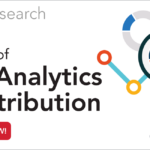The power of AI as a competitive differentiator is far from being defined. That was the subject of MDM’s latest QuickTake Podcast, where James Dorn of the Dorn Group and MDM CEO Tom Gale discussed analytics in distribution and the ways organizations are building premiere capability.
With the advent of AI — and with expectations of it evolving in the coming years — its use is changing from descriptive (the past) to predictive (planning for the future), Gale said. “This is where the organizations are really starting to push the envelope in terms of predictive capabilities,” he said.
MDM’S SHIFT Conference, held Sept. 18-20 in Denver, brings together distribution leaders to learn and network across topics of sales & marketing, digital transformation, data analytics and talent management. Find more info here.
Dorn took it a step further, calling AI capabilities “your central nervous system for operating your entire operation.” And he pointed out that interpretation of data and analytics were not the same thing.

“There’s hindsight, you know, having a hindsight view on how to use data and analytics,” Dorn said. “And that’s more along the lines of ‘Hey, what happened in our business? How can we evaluate the data that we’ve been seeing with customer transactions, with what products we have with what inventory levels we have?’ And a lot of companies are in this bucket today. They’re kind of using data analytics through the rearview mirror of a driving analogy here. They’re only looking at what’s occurred in the past.”
Evolving to use more predictive analytics has benefits for a company top-to-bottom. Dorn referred to it as “Master Data Management,” where companies are aggregating data across customers, products, suppliers and market data that is captured.
“Having that all that at your disposal, and being able to leverage it in a lot of different ways and make it accessible to your entire operation, that’s really what we’re referring to when we’re saying building out data and analytics capabilities,” Dorn said.
Companies are truly using AI and predictive analytics effectively when they are using data to help them understand not only where they can go, but how they can add value to their customers,” he said. “And using that data in more of a predictive manner to help you establish new efficiencies, new ways in which you can drive value to your customer base.”
And historic descriptive data is still very valuable. Companies can use backlogs of data to evaluate what trends are coming and what products and inventory levels they should have to service new demand — coming either from new customer segments or new markets that they might be servicing, Dorn added.
“So, it’s kind of understanding data and analytics through that hindsight rearview mirror versus that foresight windshield type of perspective,” he said. “You want to move closer into looking at, or leveraging data analytics into more of this forward-looking, foresight type of positioning to help you add value to your customers.”
Check out the full episode via the audio player above, and find all of our past MDM Podcast episodes here.
Related Posts
-
See MDM’s latest research into the utilization of data analytics in distribution — including barriers,…
-
James Dorn shares insights on leveraging voice of customer, associate and supplier research to inform…
-
Having discussed the shift from a gen-one to gen-two distributor, Mike Marks and Tom Gale…






